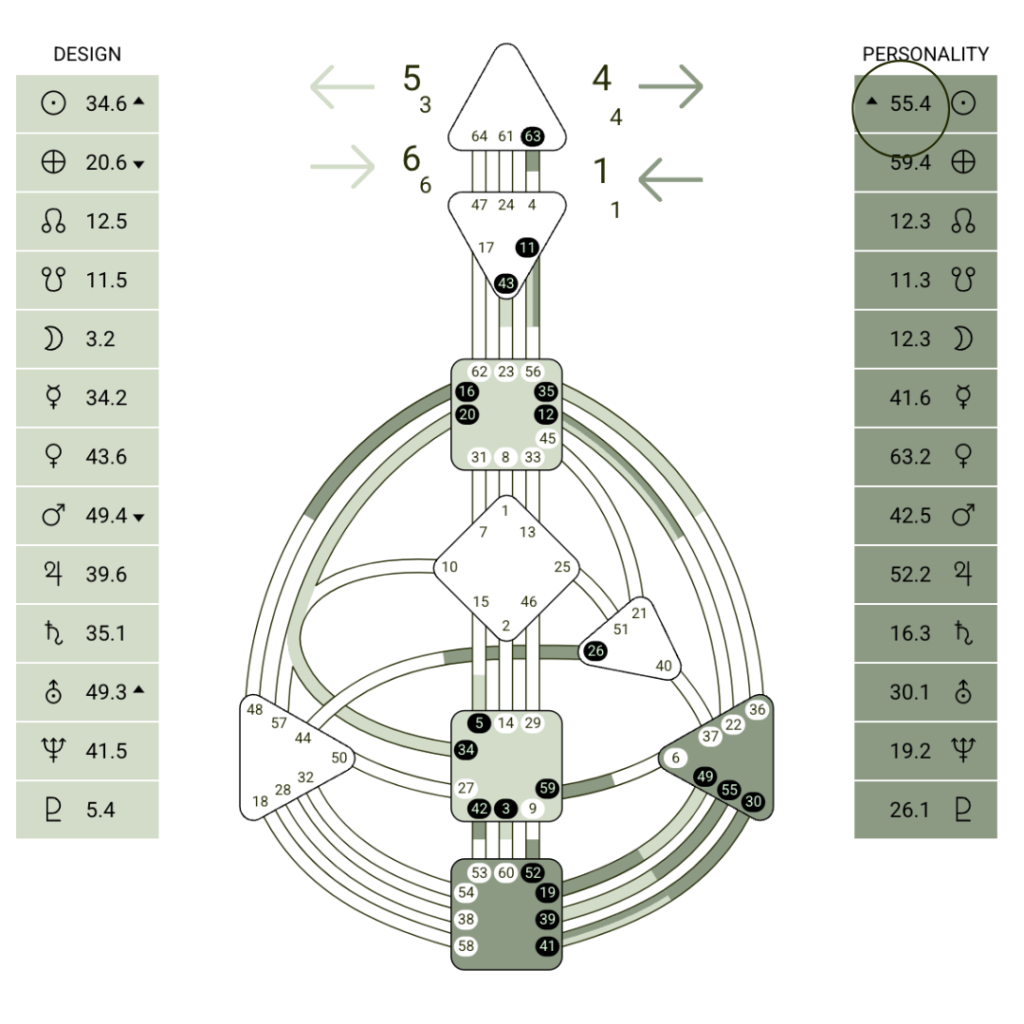When you look at your human design chart, you’ll see a whole bunch of numbers listed in two columns – 13 in each column for a total of 26.
Each of the 26 numbers in the two columns has a decimal point (a “dot” if you will), and some numbers may even have an arrow or star printed next to them in the column. So… what the heck do the numbers and symbols mean? It’s actually simpler than you might imagine.
Take a look at the sample chart below.
At the top of the right-hand column, you’ll see the number 55.4 followed by an “up” arrow. In human design lingo, the number before the decimal (55) represents a gate, the number after the decimal (4) represents a line, and the “up” arrow represents the line’s polarity.

Okay, so what do THOSE things mean?
Gates and lines are among the most crucial and exciting aspects of human design because they’re the building blocks of understanding who you are and how you reveal yourself to the world on an everyday basis.
Unfortunately, many human design teachers and services end up either oversimplifying gates as energetic “gifts,” or confusing beginners (maybe even scaring them off entirely) by attempting to explain too much too early. We think we can do a better job.
As we discussed in “The Basics,” gates are the themes of the human experience.
There are 64 gates in the human design system, and each one represents a theme of the human story. Everyone on earth embodies these 64 themes at various points throughout their lives, but a certain number of themes are imprinted on each of us genetically. These gates are always active, meaning they’re far more likely to exert their patterns of influence at any given time, and in a consistent manner.
So that’s enough about gates for now. No, seriously.
The reality is, far too many human design tutorials focus on gates. We don’t think that’s the best tactic. Why? Well, for starters, there are 64 of them and they’re hard to keep track of when you’re just starting out. In your chart, you’ll see the gates randomly clustered into the squares and triangles, without any discernible pattern, like someone just took a deck of cards and flung them on the floor. Imagine trying to remember 64 items to buy at the grocery store – even if you know what every item is, you won’t necessarily be able to recall them or fit them into the larger whole (recipes, meal plans, etc) without a reference guide. That’s what can happen with the 64 gates – they’re ultimately very important (and fun!) to understand, but they don’t exactly stick in the memory, especially when you’re just starting out on your journey.
Long story short – gates are a pivotal part of understanding the full picture of yourself according to human design, but we think they’re best saved for later, after you’ve gotten some solid footing by learning about concepts that are less expansive. And lines are one of those concepts.
Compared to gates, lines are much easier to grasp when you're looking at your chart.
In fact, one of the best ways of getting to know yourself according to human design is simply by counting up the 1s, 2s, 3s, 4s, 5s, and 6s that appear after the decimal points in the two columns of your chart.
As we discussed in “The Basics,” the six lines of human design are the patterns of thought, expression, behavior and emotions that determine how we embody those active themes throughout our lives. Reduced down, these six patterns are driven by six interlocking but distinct prime motivations:
Line 1 – Security
Line 2 – Autonomy
Line 3 – Novelty
Line 4 – Assistance
Line 5 – Impact
Line 6 – Transcendence
All of humanity embodies a mixture of these six primary reasons for living.
Each of the 26 entries in the two columns in your chart represent thematic patterns, which were imprinted on your very DNA, and which taken together add up to who you uniquely are at every level of your existence.
This is where the columns in your chart become easier to understand. The left-hand column represents your unconscious self, the traits and aspects that operate below the surface, which you can’t directly access with your mind. The right-hand column represents your personality, the traits and aspects that you identify as being “you,” which you can actively explain or contemplate by using your mind. Do you find yourself identifying more with the 13 patterns you see in the right-hand column? That would make sense because it’s literally… in your mind!
When you look at the breakdown of the six lines across the 26 numbers in your chart, take a moment to reflect on those prime motivations, how they sit in relation to each other, and what they mean to you in your life.
As a last step, let’s talk about polarity. Like a magnet, which can attract or repel another magnet, a majority of the thematic patterns in human design have a dual potential, where they’ll manifest “this” way or “that” way in someone’s life. Usually the thematic patterns have no discernible polarity over the course of a lifetime: they’re a complex mixture of “this” way AND “that” way, in varying degrees: a push and pull depending on the situation or circumstances.
However...
Do you see any arrows or stars in the two columns of your chart, after a particular gate/line combination?
These are very interesting areas of your human design because they reveal your imprinted tendencies, where your patterns are fixed within a certain range of expression, in either “this” way (up arrow), “that” way (down arrow), or “seesaw” swings between both ways (star). In human design, tendencies are not necessarily positive or negative: they simply reveal a direction that expression in life is more likely to take.
Since there are six possible patterns (lines) for each of the 64 themes (gates), it means that there are 384 total thematic patterns within the human experience. When you add in the additional layers of individual tendencies (polarity), it means that there are over 1,000 possible ways of being created by gates, lines, and polarities alone. And that doesn’t even take into account the myriad ways in which gates, lines, and polarities interact with each other to add up to the sum total of an individual human being.
So despite what you may have been told as an adult, we’re all unique (on fleek) snowflakes, and with human design, you can explore just how you’re different from (and similar to) everyone else.
Gates and lines have additional dimensions that are important for understanding both channels and profiles, so let’s keep this rolling!
Go ahead and check out our posts entitled “Your Life in HD: Profiles” and “Your Life in HD: Channels and Centers.”
